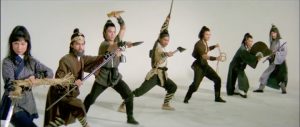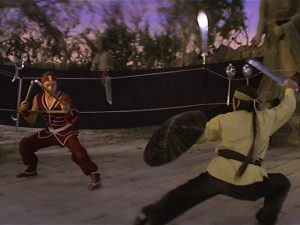Under the Hood: Kung Fu in Art of Wuxia

Each kung fu style is associated with a separate warrior of the <insert kung fu style> skill. We’ve covered that before. What I want to talk about this time is what a kung fu style looks like in the game in terms of game mechanics.
A kung fu style description contains the following parts; cool name, defined as internal or external, a description if the style, weapons taught by the style, and finally the techniques offered.
Internal or External: there are two sets of chi abilities that are trained in kung fu. Internal styles teach one set first, then later on the other. External styles teach them in the opposite order. Both internal and external stylists can eventually learn all of these chi abilities.

Weapons taught are the weapons that are most effective with the style. Players can certainly use other weapons and improvised weapons at any time. They can even add weapons to their style to add a little uniqueness to their character. In the beginning, they will want to use the weapons taught by their style until they gain some experience.
Kung Fu techniques are generically named. The Bowing Dragon monks don’t actually have a technique called Arrow Cutting. It might be called, “Thousand Arms Defense”, or “Eagle Deflection”. Another style might call it “Crane Catches the Carp” or “Dancing Lake Brush”. Arrow cutting the technique can represent as many different techniques as kung fu styles that use it. Players are encouraged (with an in-game mechanic) to come up with names for their kung fu techniques and even describe what they look like.
Here is a preview of two kung fu styles that are showcased in the various gaming convention scenarios I’ve run. Enjoy!
BOWING DRAGON (Internal)
This style is taught exclusively to Bowing Dragon Monks. They practice humility and study the harmonies of chi. Many Bowing Dragon monks have levels in the mystic skill. Their renowned Bowing Dragon style combines kicks, back fists, knee strikes and the use of the common staff and a few no-so-common weapons.
Weapons: Bo Staff, Spear, Three-section staff, and Meteor hammer
Techniques: Arrow Cutting, Chi Resistance, Disarm, Keep at Bay, Meditation, Power Defense, and Riposte
FIERY DRAGON (External)
This energetic style uses close in strikes, accupoint strikes and short quick kicks. It is taught in all areas of Jianghu.
Weapon: Chain Whip, Crescent Moon Knife (pairs), Iron Wrist Rings (both wrists), Lajatang and Nunchuku (single or pairs)
Techniques: Accupoint Strike, Danger Sense, Move-By, Multiple Defenses, One Against All, and Two-Weapon Fighting



